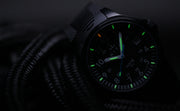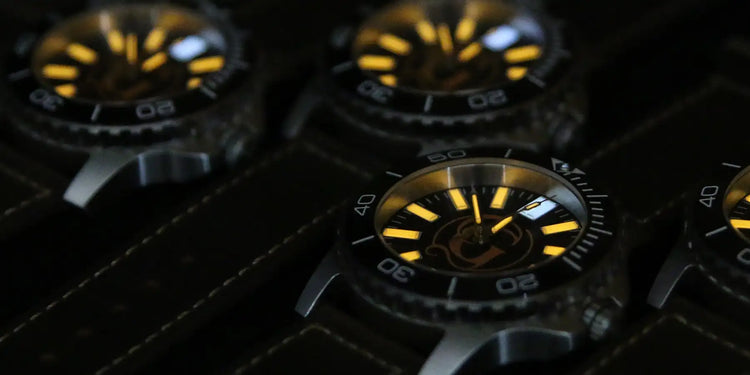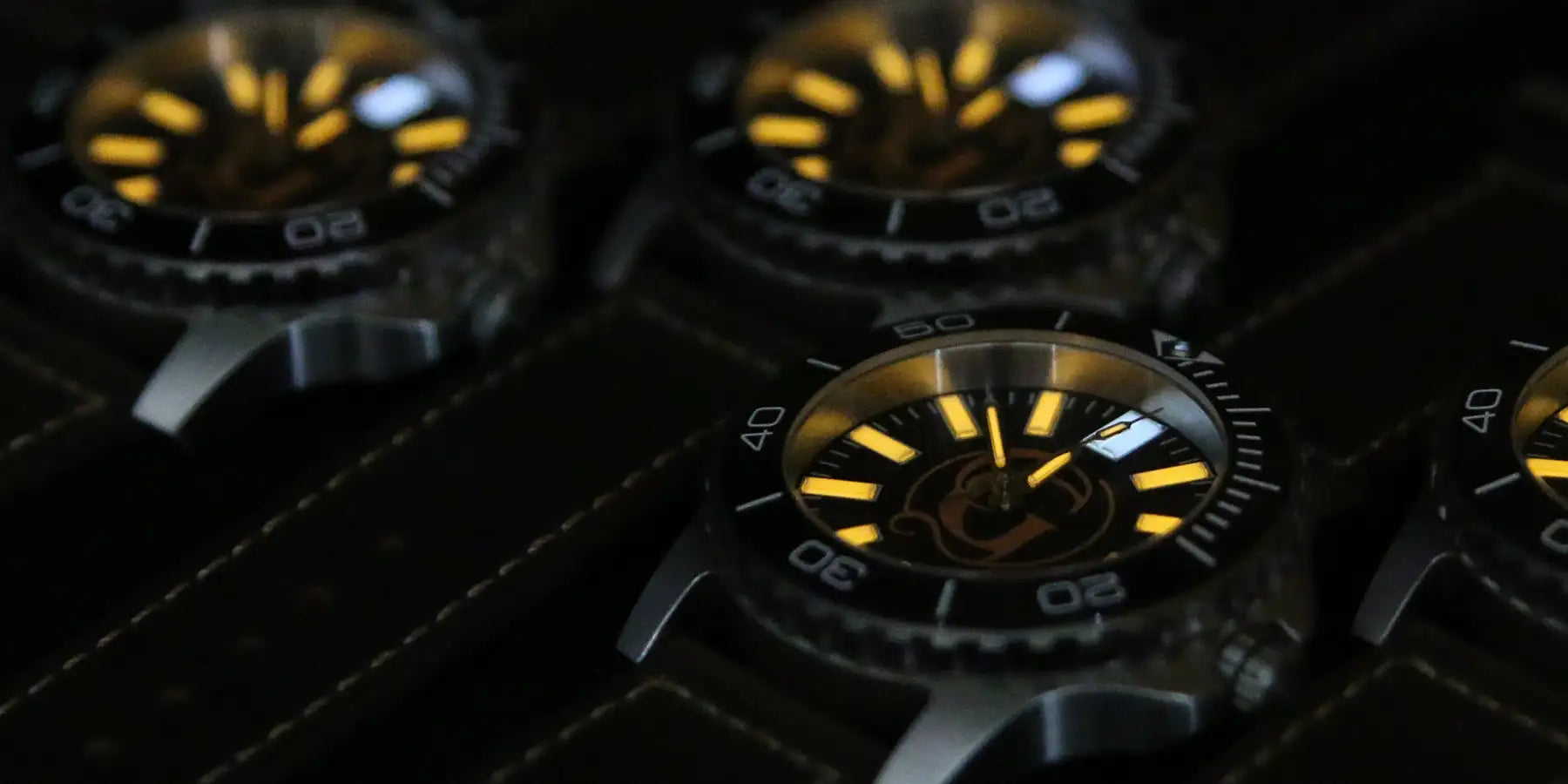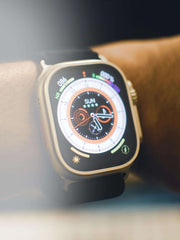Key Takeaways
- Tritium radiation is so weak it can't penetrate human skin or even paper
- UK Special Forces have safely used tritium watches like the MX10 for decades
- A tritium watch gives you 300 times less radiation than a single chest X-ray
- All tritium watches are strictly regulated and approved for consumer use across the UK and EU
- Common fears about tritium causing cancer or accumulating in your body are scientifically unfounded
- Pregnant women and children can safely wear tritium watches with no special precautions needed
- Even if a tritium watch breaks, health risks remain negligible, tritium disperses rapidly in air
Introduction: Setting the Record Straight
Tritium safety concerns surface regularly amongst watch buyers, and we understand why. When you hear "radioactive," natural caution kicks in. After two decades of supplying equipment to those who can't afford failure, including UK Special Forces who've relied on our MX10 for operational use, we can address these concerns with authority.
The radiation from tritium illumination is so minimal that natural background sources deliver thousands of times more exposure than wearing a tritium watch.
Understanding Tritium Radiation: Why It Can't Hurt You
Tritium produces extraordinarily weak radiation that cannot penetrate human skin. Unlike stronger radiation sources, tritium's energy output is so limited that it stops at the dead layer of skin cells on your body's surface.
The particles travel approximately 6 millimetres in air before stopping completely. Your skin represents an impenetrable barrier to this form of radiation.
Our MX10 field watch demonstrates this principle in practice. Originally selected for UK Special Forces operations, this timepiece contains tritium safely sealed within borosilicate glass tubes.
![[Base Image Night]](https://cdn.shopify.com/s/files/1/0585/0562/5809/files/mx10_201_front_night_3_953b8df3-a9f8-44d1-ac4c-331792ae1d6f.png?v=1732205144)
This fundamental limitation means tritium watches present zero external radiation hazard during normal wear.
Military Safety Record: Two Decades of Proven Performance
Military adoption provides compelling evidence of tritium safety. Our MX10 wasn't selected for Special Forces issue based on appearance, it earned approval through rigorous safety evaluation under extreme conditions.
Over two decades of supplying tritium watches to military professionals, we've maintained a perfect safety record. Military testing protocols examined tritium watch safety under conditions far exceeding civilian use, confirming negligible radiation exposure.
Radiation Exposure Reality: Comparing Actual Numbers
Tritium watch radiation exposure measures less than 0.1 microsieverts annually during normal wear. These represent verified measurements from nuclear safety authorities.
Consider these comparative exposure levels:
- Natural background radiation in the UK: 2,200 microsieverts annually
- Single dental X-ray: 5 microsieverts
- Return flight to New York: 80 microsieverts
- Tritium watch: Less than 0.1 microsieverts per year
Natural background radiation delivers over 20,000 times more exposure than wearing a tritium watch. A single transatlantic flight generates 800 times more radiation than annual tritium watch wear.
Our Hawk series demonstrates this safety principle through professional applications where reliability matters.

These measurements represent documented radiation levels verified through independent testing across multiple countries.
Regulatory Safety Framework: Comprehensive Oversight
Tritium watches operate under stringent regulatory oversight from nuclear safety authorities. In the UK, the Office for Nuclear Regulation maintains comprehensive protocols governing radioactive materials in consumer products.
Every legitimate tritium watch must satisfy specific safety standards before market approval. Our tritium illumination technology sources from Swiss manufacturers operating under internationally recognised nuclear safety protocols.
Mandatory testing includes leak detection, impact resistance, and long-term containment verification.
Debunking Common Safety Myths
Myth: Tritium causes cancer in humans. Scientific evidence doesn't support this claim. Published studies demonstrating any tritium effects require laboratory doses millions of times higher than watch exposure levels.
Myth: Tritium accumulates in body tissue. Tritium exhibits a biological half-life of approximately 10 days. Any microscopic amounts potentially entering the body undergo rapid elimination through normal metabolic processes.
Myth: Historical radium watches prove tritium danger. Early 20th century radium timepieces used radioactive paint applied directly to watch components. Modern tritium technology employs hermetically sealed glass tubes, eliminating direct contact.
Our Alpha series exemplifies modern tritium safety through professional applications.

Decades of research have consistently demonstrated tritium watch safety.
Damage Scenarios: Safety When Things Go Wrong
Even worst-case damage scenarios present minimal health risks. Should a tritium watch suffer severe impact and release tritium gas, radiation exposure remains negligible.
Tritium gas exhibits properties that enhance safety during accidental release. Being lighter than air, it disperses rapidly without concentrating in enclosed spaces.
Tritium tubes undergo robust construction designed to withstand impacts exceeding normal watch failure points. Should accidental damage occur, standard ventilation resolves any theoretical exposure.
Scientific Consensus: Independent Validation
Nuclear safety professionals across multiple countries have independently evaluated tritium watch safety. The consistent conclusion demonstrates negligible risk for normal use patterns. This represents scientific consensus based on decades of research rather than single-agency opinion.
The International Atomic Energy Agency's guidance specifically addresses tritium timepieces in consumer applications. Their safety standards establish that properly manufactured tritium watches may be sold publicly without special surveillance requirements post-sale.
The Federation of the Swiss Watch Industry maintains that modern tritium systems offer fundamental safety advantages over historical alternatives. Current technology employs hermetic sealing within borosilicate glass tubes, eliminating direct radioactive material contact.
When multiple independent nuclear authorities reach identical conclusions regarding tritium watch safety, the evidence becomes overwhelming. This consensus reflects comprehensive evaluation rather than regulatory convenience.
Consumer Safety Guidelines: Identifying Legitimate Products
Look for proper safety markings when purchasing tritium watches: "T" symbols indicating tritium content and activity level indicators such as T25 or T100. These represent regulatory requirements ensuring safety compliance.
Purchase from established suppliers who maintain proper certification and operate under nuclear authority oversight.
Long-Term Safety Performance: Proven Track Record
The tritium watch safety record spans multiple decades across military and civilian applications. This represents real-world data from millions of usage hours demonstrating consistent safety performance rather than theoretical projections.
Tritium undergoes natural decay over time, meaning radiation exposure decreases as watches age. From a safety perspective, this gradual reduction ensures exposure levels diminish rather than accumulate. Most manufacturers guarantee effective illumination for up to 20 years, during which radiation output continuously decreases.
This established track record provides confidence in tritium technology for civilian applications. When technology demonstrates decades of safe operation amongst professional users, consumer safety becomes well-established rather than speculative.
Choosing Safe Tritium Watches: Our Collection
Our complete watch collection represents two decades of tritium safety experience. From the MX10 trusted by UK Special Forces to our Alpha and Hawk series used by professional divers, each timepiece meets the highest safety standards whilst delivering reliable illumination when visibility matters most.
Frequently Asked Questions
Is tritium illumination safe for everyday wear? Yes, tritium illumination is completely safe for everyday wear. The radiation exposure from a tritium watch is over 300 times lower than a single chest X-ray and 20,000 times lower than natural background radiation.
Can tritium cause cancer? No, tritium does not cause cancer in humans. No published studies demonstrate tritium causes cancer. Laboratory studies showing any effects require doses millions of times higher than watch exposure levels.
What happens if a tritium watch breaks? Even if a tritium watch breaks, health risks remain minimal. Tritium gas is lighter than air and disperses rapidly. Basic ventilation resolves any theoretical exposure.
How much radiation does a tritium watch emit? A tritium watch emits less than 0.1 microsieverts per year during normal wear. For comparison, natural background radiation delivers 2,200 microsieverts annually, over 20,000 times more exposure.
Are tritium watches regulated for safety? Yes, tritium watches are strictly regulated by nuclear safety authorities. All legitimate tritium watches must meet specific safety standards including leak testing and impact resistance verification.
Does tritium accumulate in the human body? No, tritium cannot accumulate in the human body. Tritium has a biological half-life of 10 days, meaning any microscopic amounts are rapidly eliminated through normal metabolism.













